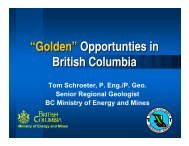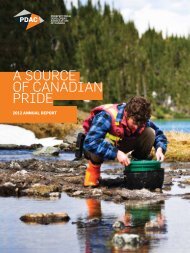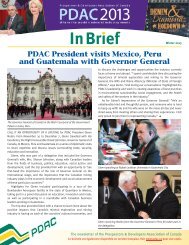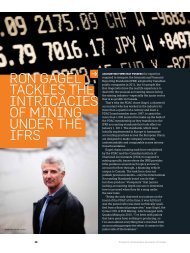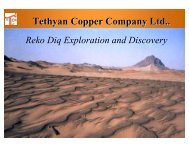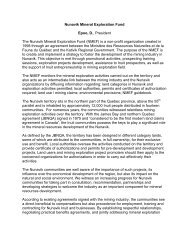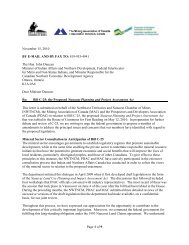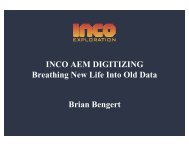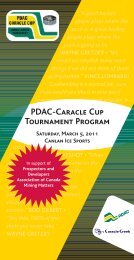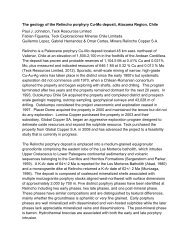Fredy Marino.ppt [Read-Only]
Fredy Marino.ppt [Read-Only]
Fredy Marino.ppt [Read-Only]
- No tags were found...
You also want an ePaper? Increase the reach of your titles
YUMPU automatically turns print PDFs into web optimized ePapers that Google loves.
1. INTRODUCTIONLOCATIONDEEP POSTGOLDDEPOSITModified after Teal and Jackson (1997)
OBJECTIVES‣ Identify the relationship between hydrothermal alteration and thestructural framework to ore zones and the geometry of the Deep Post golddeposit.‣Determine which fracture systems host gold ore.‣Determine if fracture density controls the distribution of ore grades.‣Identify and characterize the main styles of hydrothermal alterations inthe orebody.‣Establish a paragenetic sequence of structures, hydrothermal alterationand ore minerals.‣Define gold mineralization styles.‣Develop a genetic model for gold mineralization at the Deep Post deposit.
MINING HISTORY1907: Lynn Creek placers; originating from Big Six1946: Discovery of Au at Bootsrap1959: Au found in turquoise workings at Blue Star1961: Discovery of Carlin.1962: Discovery of Au in discovery of Au in Goldstrike1965: Carlin production commences (11 Mt at 0.32 opt)1978: Goldstrike production commences (western area)1982: Discovery of Post oxide1984: Discovery of Genesis1986: Discovery of Deep Post
MINING HISTORY1988: Discovery of Deep Star, Rodeo, Goldbug & Meikle1994: Discovery of West Leeville1996: Underground production starts at Deep Star & Meikle1997: Deep Intercepts in Little Boulder Basin (>6000 feet)1999: Underground production starts at Deep Post2000: Deep intercepts at Ren2001-2002: Deep Intercepts at Gold Margin CorridorGold production until year 2002:50 Million Ounces
METHODSA. Field phase.üDATA COLLECTIONüINTERPRETIVE MAPS- Faults, joints, and fractures - Fracture Intensity‣ Width of damage zone‣ Filling material‣ Kinematic indicators‣ Continuity- Sense of motion‣Dextral strike-slip displacement‣Sinistral strike-slip displacement‣Reverse displacementNumber of fractures/ 1 meter or 1 foot- Filling materialClay + sulfidesClay gougeSulfidesBarite + realgar + orpimentQuartzCarbonatesStibnite
METHODSüDATA COLLECTION-Timing and crosscuttingrelationshipsStructural paragenesis- Lithology• Biotite-feldspar porphyry• Calc-silicate rocks• Goldstrike Intrusion• Popovich Formation• Roberts Mountains Formation- Sample Collection• Samples along structures• Representative rock samples- Structural attitudes•Strike/Dip of faults, joints & fractures•Bedding• Mesoscopic folds• Parasitic folds• East or west limb of the anticline• Fracture Vs Compositional Layering
METHODSB. Laboratory phase Gold analysis (Newmont Lab)XRD (University of Nevada)ICP/mass spectrometry (Chemex)C. Petrographic phaseThin-polished sectionsMineralogical paragenesisD. Data analysis and interpretationE. Model development
2. GEOLOGY
CROSS SECTIONDEEP POST GOLD DEPOSIT
STRUCTURESFAULTSPost FaultDormant Hangingwall FaultHangingwall Shear FaultProdillon FaultFOLDSPost anticlineBetze anticlineBRECCIASDebris Flow BrecciaDissolution-Collapse BrecciaFault BrecciasHydrothermal Breccias
STRUCTURESFAULTS1. Hangingwall Shear Domain (WNW/SW) 2. Dormant Hangingwall Domain (NNW/SW)Equal Area(Schmidt)NEqual Area(Schmidt)N324/67299/64053,18328%20%24%16%20%12%16%8%12%4%8%4%Axial N = 82Axial N = 223. Prodillon Domain (NW/NE)4. NE – NNE Domain (NE-NNE/NW-SE)
STRUCTURESFOLDS
STRUCTURESBEDDING ATTITUDEEqual Area(Schmidt)NvLEVELS:v4270 Red3vv4210 Green4150 Purple2vv4080 Blue4020 Yellow1Axial N = 423Newmont data + this project data
BRECCIAS
3. GEOCHEMISTRYAu vs TlAu vsTeGold (oz/ton)1010.10.01N=110R=0.84Gold (oz/ton)1010.10.01N=110R=0.79Gold (oz/ton)0.001100.10.010.0010.001 0.01 0.1 1 10 100 10001N=110R=0.65Thallium (ppm)Au vs Ag0.001 0.01 0.1 1 10Silver (ppm)Gold (oz/ton)0.0010.001 0.01 0.1 1 10 100Tellurium (ppm)Au vs Cu10N=1101 R=0.650.10.010.0010.001 0.01 0.1 1 10 100 1000Copper (ppm)Typical pathfinderelements Silver,Mercury, Thallium,Copper, Tellurium,and antimony showstrong positiveCorrelation with gold.Au vs HgAu vs SbGold (oz/ton)10N=1101 R=0.730.10.010.0010.001 0.01 0.1 1 10 100 1000Mercury (ppm)Gold (oz/ton)10000.001000.00N=110100.00R=0.3410.001.000.100.010.000.00 0.01 0.10 1.00 10.00Antimony (ppm)
4. HYDROTHERMAL ALTERATION
5. GOLD CONTENTS
Pre-ore stage (Lower Paleozoic-Upper Mesozoic)6. Schematic Model ofThe Deep Post MineMain-ore stage (Lower Tertiary- ~40 Ma)Late-ore stage (~40 Ma- Present)
7. ConclusionsA. CROSSCUTTING RELATIONSHIP1 2 3 34 5 6 77 8 8
ConclusionsB. STRUCTURAL PARAGENESISTimeOLDESTSTRIKEOrientationDIPMineralogyTemporalrelation to OreStructural Domain1 ENE NW Sulfides+Qz Pre-ore2 NS W Non mineralized; Clay gouge Pre-ore3 NS E Sulfides+clay gouge; Rea+Qz; Early ore event4 WNW NE Sulfides+clay gouge; Rea+Orp+Ba Main ore stage5 NW SW Sulfides+Clays; Rea+carbonates; Stb Main ore stage6 NW NE Sulfides+Clays; Rea+orp; Qz Main ore stage7 NNW NE-SW Sulfides+Clays Main ore stage8 NNE NW-SE Sulfides+Clay; Carbonates+Rea Late9 NE NW Clay+Sulfides (oxides); Stb Post-oreHangingwall ShearZone DomainDormant DomainProdillon andPowerful DomainDormant DomainNNE DomainNE DomainYOUNGEST10 EW S Non mineralized; Clay gouge Post-ore
POTENTIAL SIGNIFICANCEüA Better understanding of the structural controls for mineralizationüA Better understanding of the geometry of the secondary feeder zonesüA Better understanding of the relation between hydrothermalAlteration, structural geology and gold grade content.üExploration key for deeper Carlin-type gold deposits.
7. ConclusionsGold grade distribution at DeepPost shows stratigraphic andStructural controls.Stratigraphic control is manifestedIn the location of the highest gradeOre within the upper unit of theRoberts Mountains Fm. and theLower unit of the Popovich Fm.Structural controls resulted in higherore grades include anticline hingeZones, and the presence ofhigh-grade shoots along faultsand fault intersections.
ACKNOWLEDGEMENTSUNR ADVISORSNEWMONT STAFFDr. Richard SchweickertDr. Tommy ThompsonDeep Post GeologistsSteve GarwinFUNDING PROJECTRalph J. Roberts Center for Research in Economic GeologyNewmont Mining CorporationTHANKS


![Fredy Marino.ppt [Read-Only]](https://img.yumpu.com/46988510/1/500x640/fredy-marinoppt-read-only.jpg)
